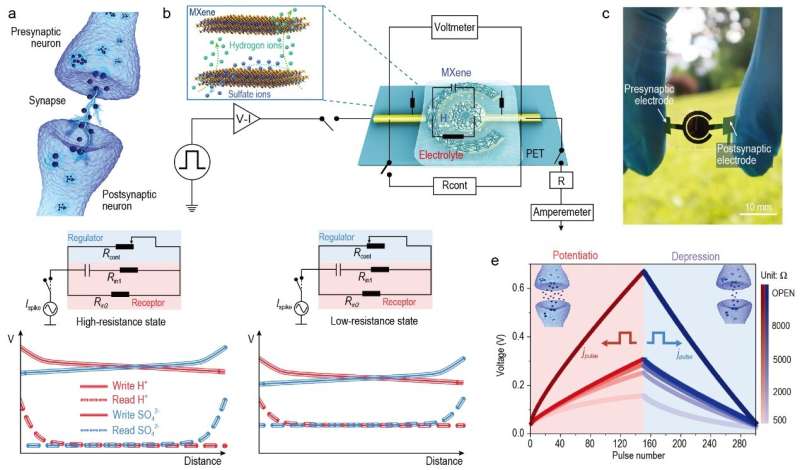A novel integrated system of neuromorphic devices

Neuromorphic computing is an information processing model that simulates the efficiency of the human brain with multifunctionality and flexibility. Currently, artificial synaptic devices represented by memristors have been extensively used in neural morphological computing, and different types of neural networks have been developed.
However, it is time-consuming and laborious to perform fixing and redeploying of weights stored by traditional artificial synaptic devices. Moreover, synaptic strength is primarily reconstructed via software programming and changing the pulse time, which can result in low efficiency and high energy consumption in neural morphology computing applications.
In a novel research article published in the Beijing-based National Science Review, Prof. Lili Wang from the Chinese Academy of Sciences and her colleagues present a novel hardware neural network based on a tunable flexible MXene energy storage (FMES) system.
The system comprises flexible postsynaptic electrodes and MXene nanosheets, which are connected with the presynaptic electrodes using electrolytes. The potential changes in the ion migration process and adsorption in the supercapacitor can simulate information transmission in the synaptic gap. Additionally, the voltage of the FMES system represents the synaptic weight of the connection between two neurons.
Researchers explored the changes of paired-pulse facilitation under different resistance levels to investigate the effect of resistance on the advanced learning and memory behavior of the artificial synaptic system of FMES. The results revealed that the larger the standard deviation, the stronger the memory capacity of the system.
In other words, with the continuous improvement of electrical resistance and stimulation time, the memory capacity of the artificial synaptic system of FMES is gradually improved. Therefore, the system can effectively control the accumulation and dissipation of ions by regulating the resistance value in the system without changing the external stimulus, which is expected to realize the coupling of sensing signals and storage weight.
The FMES system can be used to develop neural networks and realize various neural morphological computing tasks, making the recognition accuracy of handwritten digit sets reach 95%. Additionally, the FMES system can simulate the adaptivity of the human brain to achieve adaptive recognition of similar target data sets. Following the training process, the adaptive recognition accuracy can reach approximately 80%, and avoid the time and energy loss caused by recalculation.
"In the future, based on this research, different types of sensors can be integrated on the chip to further realize multimodal sensing computing integrated architecture," Prof. Lili Wang stated, "The device can perform low-energy calculations, and is expected to solve the problems of high write noise, nonlinear difference, and diffusion under zero bias voltage in certain neural morphological systems."
More information: Shufang Zhao et al, Neuromorphic-computing-based adaptive learning using ion dynamics in flexible energy storage devices, National Science Review (2022). DOI: 10.1093/nsr/nwac158



















